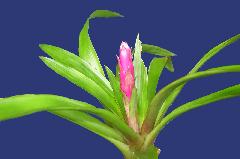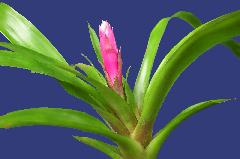

From Gouda in Flora of the Guianas 1987
4. Guzmania melinonis Regel, Gartenflora 34: 116. 1885, as "Guzmania melinoki", a typographical error according to Mez, in DC. Monogr. Phan. 9: 908. 1896.
Type: Linden in Petrograd Hortus s. n. (holotype LE?, not seen); French Guiana, without locality, Melinon 37 (clonotype P).
Plant acaulescent, 25-45 cm tall, with a funnelform rosette of about 10 or more lustrous-green leaves.
Leaves subchartaceous, 30-55 cm long, much exceeding the inflorescence;
sheaths more or less distinct, tapering into the blade, elliptic, 10-13,5 x 5-6 cm, densely and minutely appressed-lepidote with pale-brown scales, pale dull-brown;
blades arching, ligulate, with distinctly veined surface when dry, 24-45 x 2-4( -6.3) cm, attenuately acute or obtuse and acuminate, sparsely and minutely appressed-lepidote or subglabrous.
Inflorescence simple 10-28 cm long;
scape erect or curved, appearing stout by its bracts, 5-20 cm long, glabrous, densely covered by bracts;
scape bracts erect, densely imbricate, chartaceous, ovate, with narrow-triangular blade or more acuminate, 2-3 times as long as the internodes, sparsely appressed-lepidote at least at the apex;
spike (slenderly) ellipsoid, 6-8,5 x 2-3 cm, obtuse or acutish, densely and polystichously 8-15-flowered, often entirely fertile at the apex;
rachis hidden, straight, angled(?), glabrous;
floral bracts erect, densely imbricate, chartaceous, with veined surface when dry, elliptic, (2-)3.4-4 cm long, about 5 times as long as the internodes, about twice as long as the sepals, with broad hyaline margins, broadly rounded and apiculate to emarginate, ecarinate, subglabrous, often obscurely lepidote toward the apex, bright orange.
Flowers erect, sessile;
sepals coriaceous, with even surface, elliptic, 1-2 cm long, with membranaceous margins, obtuse, slightly incurved at the apex, less than half connate, ecarinate but the posterior ones with thickened midvein below, often castaneous, glabrous;
petals 3-4 cm long (exceeding the floral bracts), ligulate, obtuse, connate for most of their length, with slightly spreading lobes, yellow;
stamens included, just exceeding the pistil, filaments flat(?), adnate to the petal-tube, anthers dorsifixed, ca. 6 mm long;
ovary ovoid, ca. 6 mm long.
Capsule cylindric, 3.5-4 cm long, long beaked; coma white.
Distribution: Panama, Greater Antilles, Colombia, Surinam, French Guiana, Ecuador, Bolivia and Amazonian Brazil. Saxicolous on limestone and epiphytic in forest, 150-3000 m alt. 10 collections studied. Surinam: Jodensavanne - Mapane Kreek area, Maas 3168 (U, US). French Guiana: Montagne de la Trinite, de Granville 6582 (CAY, U); without locality, Benoist 684 (P); Mana, Melinon 37 (P); near Saul, Cremers 6087 (US); near Saul, Ek & Montfoort 162 (U); Massif des Emerillons, de Granville 3902 (CAY).
Culture and use: Easily grown at a shady and humid location; a beautiful single-spiked bright colored Guzmania, unfortunately, the color does not last very long.
Note: Guzmania melinonis is known from Colombia, Surinam, French, Guiana, Ecuador, Bolivia and Amazonian Brazil. Two collections studied (named G. erythrolepis Brongniart) probably G. desautelsii R. W. Read & L. B. Smith from Costa Rica are difficult to distinguish from the Guiana material of G. melinonis, except for the petal color.
From Luther in J. Brom. Soc. 35(2): 77. 1985
Guzmania melinonis Regel
This widespread species is native to wet forests from the Guianas to Peru and Bolivia. In the Andean regions it is restricted to the eastern (Amazonian) slopes usually at fairly low elevations. It can be characterized by a simple, ellipsoid inflorescence with broad red or orange floral bracts and bright yellow tubular flowers. In Ecuador the only species of similar form and coloration are G. fusispica Mez & Sodiro and G. bracteosa (Andre) Andre ex Mex both of which are native to the western slopes of the Andes. Cultivated specimens of G. melinonis are often labelled as G. berteroniana (native to Hispanola and Puerto Rico) or G. erythrolepis (Panama and the Greater Antilles). Most of the cultivated plants originated in Amazonian Ecuador, Peru, and Bolivia. Figure 10 shows a plant from Napo Province, Ecuador, which flowered at Selby Botanical Gardens, Sarasota, Florida.
GUZMANIA QUITENSE by RICHARD OESER, M. D in Brom Soc Bull. 18(4): 96. 1968. Treated as G. melinonis var quitensis and then to G. remyi
Guzmania quitense is a close relative of the commonly known G. monostachia, shown in color on the front cover of Bulletin XVII, No. 5, 1967. The structure of the flower spike and the white flowers are much alike in both species, but the colors of the bracts differ. Those of G. quitense are a mellow pink, diffusing to white at the tips. The leaves of the rosette have a brownish-red hue, while those of G. monostachia are generally pale green.
This new species, as yet quite rare, comes from the area around Quito, Ecuador, as its name suggests. It does well under ordinary pot culture. So far I have not been able to produce any seed or know of anyone who has. G. monostachia is self fertile and usually sets plenty of seed.- Germany.